If Massimo Tambourine had not broken his Honda 750 four racetrack in Misano in September 1972 the legend that is now Bimota might never have existed. After recovering from three broken ribs he began the construction of a tubular steel frame to cope with the horsepower engines produced by major Japanese manufacturers. This frame has reduced the weight of the original Honda and lowered the center of gravity and by the HB1, of which only ten were made, the story begins.Bimota appointed the initial drift of the three founders, Bianchi, Morri and Tamburini, but it was the passion and excellence in technology Tamburini was the driving force behind the company.
The packaging frames Bimota started to produce, as YB1, YB2, Yb3, HDB1, hdb2 and SB1 became a have for all serious racers and quickly altered the perception of what motorcycle should be.Bimota in 1977 identified a market place and have started to produce bicycles exclusive high performance such as the SB2. Some of these models are sold in kit form, but the development of the now legendary KB1 creating the main turning point in the commercial success of the company.The'80s provided the main success for the small factory based in Rimini on the track and through the development of a range of machines for road dreamy. But it was also a period of transition with Tamburini leaving the company in 1983 to be replaced later by the talented young engineer Federico Martini who proceeded to write a whole new chapter in the legendary story of Bimota. His experience working with Ducati, leads to the development of DB1 Ducati 750 operated as well as the reinforcement of innovative aircraft alloy SCATOLATO , far ahead of its time as its basic concept is used by all Bimota throughout the'90s.The other models produced during this decade include the HB2, HB3 on the SB3, SB4 on the SB5, the YB4ei the YB6 the YB6 Exup the YB6 Tuatara, the KB2, KB3 on the DB1se and DB1rs. But it is on the racetrack with two World Championships and that Bimota Martini really make their mark. The first in 1980 for Jon Ekerold in the 350cc championship and the second in1987 for Virginie Ferrari on a Bimota YB4 R in the world championship TTT F1.Federico Martini Bimota leaves in the early'90s and is replaced as Technical Director by Pierluigi Marconi whose close collaboration with Martini started when he was still a student. Under his technical supervision Bimota focuses mainly on manufacturing models with alloy frames aircraft SCATOLATO as biposto YB8, YB8e, YB8 Furano, YB9 Bellaria, YB9sr, YB9sri, YB10, YB10, YB11, DB2, DB2sr, DB2ef, DB3 casting - SB6, the SB6R, the SB7, the SB8R Supermono the biposto and 500 Vdue of Supermono. The model, however, that characterizes the genius and innovation of Pierluigi Marconi and Bimota during this period is driven by hub TESI 1D created in various versions including the 1 / D 1 / D SR, 1 / D es, 1 / D EF.The'90s also saw the departure of the last remaining founder of Bimota when in 1993 Giuseppe Morri part to be replaced as CEO by Walter Martini. Martini in the company doubling production in 1995 and 1250 product cycles. In 1996 Bimota commemorates its 25 anniversary with a big event to the track in Santa Monica where Misano bimotisti band around the world to join in the celebrations. In the late'90s the first all Bimota bike between the drawing board in the full production of 500 Vdue. Designed by Robbiano and engineered by Marconi, this bike was created as a bike Moto GP for the road. Powered by a Bimota engine twin-cylinder 500 cc, customers demanded immediate delivery. Such intense demand leads Bimota to start delivery before full development is realized in conducting a recall of all bikes and a financial crisis for the company.The new millennium begins Bimota for the company under new management and cycling prestigious well received new models at the shows in the world. The best model during this period is the product SB8R in both versions of fiber, fiberglass and carbon. With SB8R, Bimota returns to its roots with an innovative frame constructed in the fiber aluminum and carbon packing a powerful engine of Suzuki.After 11 years of absence, Bimota returns to the race course participant at the world championship in Super-bike. The team under the management of Virginio Ferrari with technical director Franco Farn and rider Anthony Gobert are classified 12th in the first and second races in Kyalami (South Africa). Two weeks later at the Australian GP at Phillip Island Gobert rises to a surprising win him best Easter ever for all bimotisti around the world. Despite these fantastic results on the track, Bimota spiral develops in the serious financial crisis while the engine Vdue launched in the'90s going terribly wrong. The factory falls into bankruptcy and closes, fortunately only temporarily, the first phase of the ends of legend.After many false blades Bimota is finally resuscitated in 2003 and a new management team installed in order to build on the heritage of the Bimota name and restore the great traditions that have made the company a legend in the motorcycle design. The first positive results of this effort can be seen with reward design motorcycle in the Supersport category at the Intermot exhibition won by the new Bimota model, the DB5. Another award to add to the many others who honor the walls and trophy cabinets of the company the factory s historic Rimini.Bimota is back and with his return comes the romance and history of a very special brand. 
MCN has got the exclusive story on the new Bimota DB8 and so we managed to find that despite rumors regarding the great possibility for the Italian firm to launch a Ducati Street fighterAprilia Tuono competitor, meaning a dual-seat, 1200cc entry-level naked, the new bike will actually be a veritable super bike that offers the possibility to take your wife or girlfriend along for the ride, as Bimota spokesman Anna Carla Cuneo says: “Bimota customers are used to being surprised with new and innovative motorcycles offering unique design, good power and light weight – and many of them also have a wife or girlfriend that would like to come along. We are sure this design will be a big success.” or
Bimota hopes to sell 250 such motorcycles for $33,057 (€23,000) while still producing their DB7 model, which starts at $37,369 (€26,000). It may sound like much for the average super bike buyer, but it is what Bimota considers ‘entry level’, so I guess we weren’t too far off after all.
Built around the same consecrate oval section CroMo hybrid chassis now linked to a aluminum sub frame and featuring also Marocchi and Extreme Tech suspension front and rear, it is easy to see how building costs have been reduced, but we should also mention that the DB7’s carbon fiber fairing has been replaced with a cheaper, plastic one.
At least we’re satisfied by the fact that engineers made no concession in the engine department. As a result, the 1198 testastretta evoluzione, 4v twin cylinder 90° develops no less than 170 HP at 9.750 rpm and 131.4 Nm at 8.000 rpm. That’s even more impressive in relation to the 392.4 lbs (178 kg) weight of the bike. This means even more engine performance that the Bimota DB7 for less money. I believe we’re starting to understand the whole affordability thing. Read the full specs after the jump.
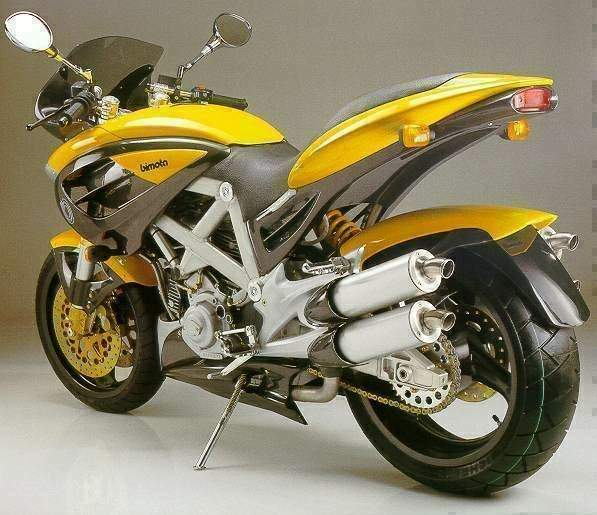
The Mantra represents an attempt to open up new areas for bimota,as opposed to the traditional niche of super sports bikes . The so called niche was that of the naked bike . The styling which was quite daring and uncompromising , as one would guess from this Rimini based manufacturer , was the work of French designer Sacha Lakic . Mantra means in Sanskrit "tool of thought" . Upon its presentation everyone thought it was only a project , given its futuristic appearance . It came as a surprise when it was marketed normally . The mantra was marketed in two series the first in Cologne in 1994 and the second in Milan in 1997 . However this change was only with minor cosmetic details such as screen , headlight , handlebars and rear mudguard . All of which will fit onto earlier bikes if required .
That was the typical reaction to the Bimota Mantra, one of the craziest bikes ever made in Italy, which is quite an achievement.Featuring an engine lifted from Ducati's mid 1990s 900SS model, with Sacha Lakic's weird chassis and bodywork wrapped around it, the Mantra was an exercise in designer chic which somehow never quite got off the ground. Bit like a gold plated Versace sandwich toaster really, interesting idea, but difficult to market.The surprising thing was how good this four pipe; walnut-dashed weird mobile was to actually ride on the road. It went, braked and handled OK and weighed as little as the average sporty 600. Good fun, but at an initial asking price hovering around £13,000 back in 1996, it was no surprise that Bimota struggled to sell many Mantras in the UK.Bimota riders are used to turning heads, but nothing the Italian firm has previously produced matches the impact of the outrageously styled Mantra. During a day on the roads around Bimota's base in Rimini, motorists stopped to stare, pedestrians stood open-mouthed and one scooter rider chased me through the resort town's traffic for a closer look.And it's not just its controversial styling that makes the Mantra special. More importantly, this is the first visible result of Bimota's recent policy to broaden its range. Traditional super sports bikes will continue to dominate, but Bimota also aims to move into new sectors of the market, to allow an increase in production. This year's total is scheduled to reach a highest ever 1400 bikes, 300 of them Mantras, with the planned limit of 1500 due to be built next year.Shaped by Frenchman Sacha Lakic and powered the sohc, two-valves-per-cylinder V-twin motor from Ducati's 900SS and Monster, the Mantra is intended to be more at home in town and on country roads than on a racetrack. But with an oval-section alloy frame and a collection of classy cycle parts, it has been created to maintain Bimota's reputation for demon handling too.There's not much doubt that Bimota's first aim, to produce a futuristic roadster with a high-tech image and a strong identity, has been achieved. The bike is unmistakable all the way from its headlamp surround - inspired by an old-style racing Ferrari's grille - to its pair of low-level mufflers on either side.No bike as boldly styled as the Mantra will be every rider's cup of vino rosso, and I'll admit to doubts when it was launched last year. But the Mantra definitely grows on you - and the opinion of those in Rimini was overwhelmingly positive.
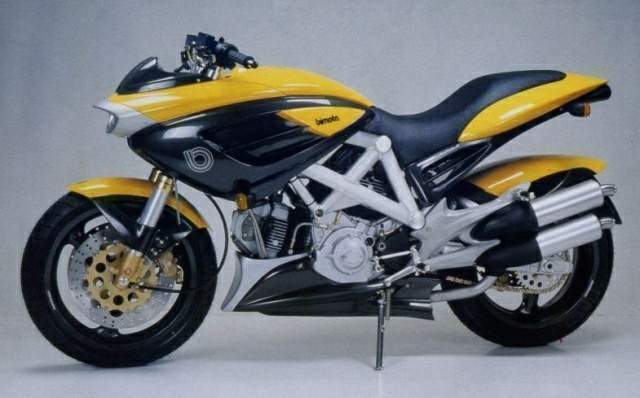
The distinctive feel continues after you've thrown a leg over a stepped dual-seat, which is fairly low, at least for the rider. Up ahead, white-faced clocks are set into a fake wood surround with a neat carbon-fiber cover. Mirrors are pear-shaped and wide apart enough to be useful - possibly another first for Bimota. Fuel is held low, in the front bodywork area at each side, leaving room for a small glove compartment in the dummy tank.Bimota's trademark milled-from-solid aluminum top yoke is in place, but the clip-on bars are raised four inches above it. They combine with reasonably forward and low set footrests to give a roomy, almost bolt-upright riding position, with your legs pushed out slightly by the bodywork.When Ducati's 904cc air-oil cooled Desmo V-twin engine fires-up, its familiar mechanical rustle blends with a fairly quiet exhaust note from those four mufflers - a set-up designed more for show than go.
The power plant itself is standard, producing a claimed maximum of 86bhp at 7000rpm. Like the Monster, its closest rival, the naked Mantra is well served by the V-twin's relatively modest top-end performance and huge reserves of mid range grunt.In town the bike was a revelation after previous racy Bimota's, with none of the normal wrist-ache. Steering lock was pretty limited, but the Mantra's lightweight - just 381lb dry - helped low-speed maneuvering. At walking pace the motor felt rather snatchy, making for erratic progress in heavy traffic. But it smoothed out above 3000rpm, and mid range response was predictably brilliant. Cracking open the twin 38mm Mikunis sent the bike charging instantly forward, its front wheel coming up easily in first gear.On the open road the Mantra's instant urge made for rapid progress and effortless overtaking, without need to cane it to the 9000rpm red line or make too much use of the six-speed gearbox. Riding a Bimota gently has never been so much fun. Revved harder, the V-twin stayed fairly smooth as it rumbled towards a top speed of about 125mph. Neither the top-end delivery nor the riding position encouraged ton-plus speeds, although a detachable windscreen is available as an optional extra.Unlike many naked bikes, the Mantra felt rock-solid at speed.
This is a Bimota, after all, and that oval-section alloy frame looks massively rigid. But handling was less quick steering than previous Rimini bikes. Presumably that was intention, as the Mantra is aimed at city dwellers and sports touring types who wouldn't normally consider a Bimota.Not that you'd suspect a thing from a glance at the spec sheet. With 24 degrees of rake, trail of just 92mm and wheelbase of 1370mm, this bike's vital statistics are almost identical to those of the super-sports DB2. Adjusting the length of the Paioli rear shock, though, so those steering geometry figures are only approximate, can alter geometry. The bike I rode was set up to turn fairly quickly and easily, but required noticeably more effort than the ultra-flick able DB2.The multi-adjustable shock sits diagonally on the right of the bike and is worked directly by the oval-section alloy swing-arm. Front suspension is similar to that used by other Bimota models, with 43mm diameter Paioli forks whose sliders are machined from solid billet.Both ends were softly sprung, at least by Bimota standards, and superbly controlled, making the bumpy hill roads south of Rimini feel deceptively smooth. Either that, or they'd all been resurfaced since my last visit. If anything the forks were slightly soft for aggressive riding, using up much of their travel under hard braking. In the absence of spring reload adjusters (optional kits are available for both reload and rebound damping), winding on a little extra compression damping helped slightly
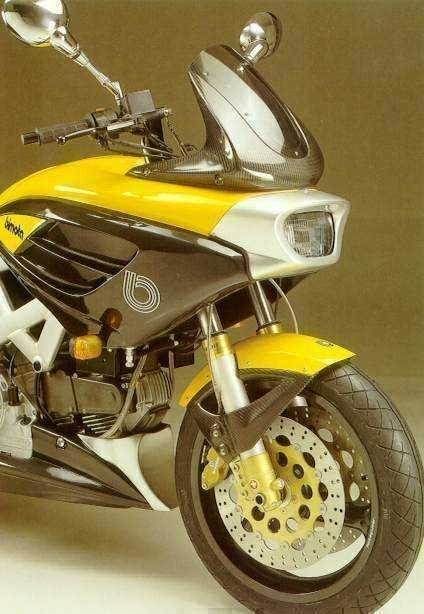
.The Mantra certainly stopped as fiercely as any race-replica, too, thanks to its light weight plus a front brake combination of twin 320mm floating discs and four-pot Brembo calipers, backed up by a 230mm rear disc. Its 17-inch wheels wore fat Michelin Macadam's, which gripped well although they're not pure sports tires. Ground clearance was excellent, with just a corner of the belly-pan touching down under extreme provocation.Despite its relaxed riding position and slightly slower steering, there's no doubt that the Mantra is a seriously quick machine that, if well set-up and ridden hard, could keep up with most sports bikes. It's a true Bimota, even if it doesn't look anything like any of the others.All of which, of course, is pretty much what its creators intended. The Mantra achieves Bimota's aim of broadening the marque's appeal, providing great performance and handling in a stunning visual package that some riders will love, others will hate and few will ignore.Naturally it's also expensive, costing considerably more than Ducati's similarly powered M900 Monster. But for riders who've always appreciated Bimota's dedication to high performance and engineering excellence, and prefer a more rounded bike to the normal Rimini diet of racy sportsters, the Mantra could just be the answer.
Review of Ducati engined Bimota's against their Ducati counterparts - by Ian Fallon with thanks.
DB3
Designed by Frenchman Sacha Lakic, the Mantra was one of the most unusually styled motorcycles of the mid to late 90's. Using a standard 904 cc M900 engine with a special four-muffler exhaust system, the output was 85.7 bhp at 7000 rpm. Every other component was different to the M900, and the Mantra was lighter and more compact. The trellis frame was constructed of oval section tubes, with a cantilever aluminum swing arm and single Paioli rear shock absorber. This gave a wheelbase of 1370 mm (53.9 inches). Front forks were 43 mm Paolina, these providing rebound adjustments. The wheels were black painted 17 inch Marchesini fitted with 120/70ZR17 TX11 and 180/55ZR17 TX23 tires. Though fully floating cast iron 320 mm Brembo front discs were featured on the publicity vehicles, the front brakes were standard 320 mm stainless steel discs with the usual Brembo P4 30/34 calipers. At the rear was a 230 mm disc with a brembo 05 Gold series caliper.
Designed by Frenchman Sacha Lakic, the Mantra was one of the most unusually styled motorcycles of the mid to late 90's. Using a standard 904 cc M900 engine with a special four-muffler exhaust system, the output was 85.7 bhp at 7000 rpm. Every other component was different to the M900, and the Mantra was lighter and more compact. The trellis frame was constructed of oval section tubes, with a cantilever aluminum swing arm and single Paioli rear shock absorber. This gave a wheelbase of 1370 mm (53.9 inches). Front forks were 43 mm Paolina, these providing rebound adjustments. The wheels were black painted 17 inch Marchesini fitted with 120/70ZR17 TX11 and 180/55ZR17 TX23 tires. Though fully floating cast iron 320 mm Brembo front discs were featured on the publicity vehicles, the front brakes were standard 320 mm stainless steel discs with the usual Brembo P4 30/34 calipers. At the rear was a 230 mm disc with a brembo 05 Gold series caliper.
It was Lakic's yellow and black bodywork that was the most controversial from the front mudguard to the belly pan, every part a new styling experiment. The smoked black windscreen was designed to be easily removed and a small baggage compartment at the rear of the fuel tank could house a rainproof suit and gloves. The tank itself was a twin saddle style to give optimum weight distribution. Most of the ancillary components were also specifically designed and built for the Mantra. This included the chrome mirrors, later used by Moto Guzzi, white-faced instruments and CEV headlight.
In 1996 the Mantra front and rear sections were restyled, and the co lours now included a red and black option. Two kits were available to bring earlier models up to the 1997 specification. There were also new handlebars, windshield, headlamp cowl, rear mudguard, uprated Michelin TX15 7 TX25 tires and it was now fitted with Ant-era wheels as standard.
As with the DB2 there was a wide range of options available for the Mantra, some of the were, Bimota Alarm, engine up rating kit and a front fork kit. More sophisticated fork action through this kit included Titanium fork tubes, along with pre load and compression damping adjustment. Production of the Mantra commenced in September 1995, the total production being 454 unit until 1998. The final 50 were constructed in November of that year. The basic Mantra frame and running gear was then used for the DB4 of 1999.
In 1996 the Mantra front and rear sections were restyled, and the co lours now included a red and black option. Two kits were available to bring earlier models up to the 1997 specification. There were also new handlebars, windshield, headlamp cowl, rear mudguard, uprated Michelin TX15 7 TX25 tires and it was now fitted with Ant-era wheels as standard.
As with the DB2 there was a wide range of options available for the Mantra, some of the were, Bimota Alarm, engine up rating kit and a front fork kit. More sophisticated fork action through this kit included Titanium fork tubes, along with pre load and compression damping adjustment. Production of the Mantra commenced in September 1995, the total production being 454 unit until 1998. The final 50 were constructed in November of that year. The basic Mantra frame and running gear was then used for the DB4 of 1999.
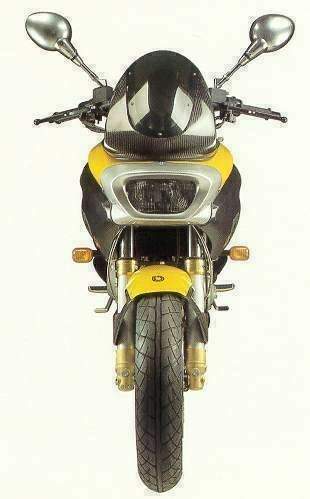
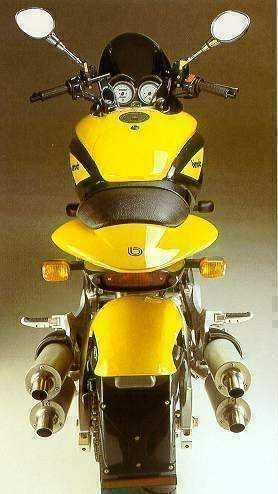
No comments:
Post a Comment